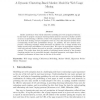Free Online Productivity Tools
i2Speak
i2Symbol
i2OCR
iTex2Img
iWeb2Print
iWeb2Shot
i2Type
iPdf2Split
iPdf2Merge
i2Bopomofo
i2Arabic
i2Style
i2Image
i2PDF
iLatex2Rtf
Sci2ools
CORR
2004
Springer
2004
Springer
A Dynamic Clustering-Based Markov Model for Web Usage Mining
Markov models have been widely utilized for modelling user web navigation behaviour. In this work we propose a dynamic clustering-based method to increase a Markov model's accuracy in representing a collection of user web navigation sessions. The method makes use of the state cloning concept to duplicate states in a way that separates in-links whose corresponding second-order probabilities diverge. In addition, the new method incorporates a clustering technique which determines an efficient way to assign in-links with similar second-order probabilities to the same clone. We report on experiments conducted with both real and random data and we provide a comparison with the N-gram Markov concept. The results show that the number of additional states induced by the dynamic clustering method can be controlled through a threshold parameter, and suggest that the method's performance is linear time in the size of the model.
| Added | 17 Dec 2010 |
| Updated | 17 Dec 2010 |
| Type | Journal |
| Year | 2004 |
| Where | CORR |
| Authors | José Borges, Mark Levene |
Comments (0)

